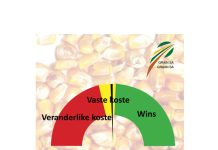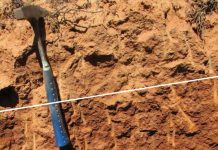Soil is the most fundamental resource for the farmer, without which food and natural fibre cannot be produced. This article forms part of a series to highlight this resource and will take a closer look at the interaction of soil water and the plant roots.
At any given moment, there is very little soil water directly in contact with the plant root, ready for absorption. In order to adequately satisfy the plant’s needs for water, there are two mechanisms in action: Firstly, the water moves towards the root and secondly the root grows into the moist soil.
Water potential distribution around a root
The plant’s leaves exist in relatively dry air and when it also hot, water is constantly evaporating from the leaf via the stomata. The water that evaporates from the leaf has to be replenished immediately to ensure the leaf does not dry out. This water shortage causes a suction tension lower down in the plant, as far as the furthermost plant roots. As a result, there is also a potential difference between the root and soil surrounding the root, with water moving from the wetter soil into the root. The root then transports the water to those parts above the ground. In fact, the leaves actually “suck” the water upwards.
As a result, the water directly surrounding the root has been absorbed and the layer of soil surrounding the root has dried out. A bit further away (about 1 mm from the root), there is still water in the soil and, as a result, a potential gradient develops: a lower matrix potential surrounding the root (greater suction or tension) and a higher potential somewhat further away. Soil water therefore moves from a higher potential (lower suction) to a lower potential (greater suction). There is now a difference in the levels of energy and this difference in energy levels results in energy becoming available to move the water from the wetter areas to the drier areas. The plant now has (new) water that it may absorb. Thus a chain reaction takes place here, as the water at 2 mm now moves to 1 mm and later into the root. It is therefore wetter further away from the root and drier close to the root. The water constantly moves from the wetter parts to the roots. If less water moves towards the roots than the atmospheric demand via the leaves, the plant is placed under stress.
Movement of water to the root
Saturated flow
When a significant shower of rain occurs or when irrigation is applied, there is a surplus of water in the upper regions of the soil and this water moves downwards due to gravitation. The water potential is high and is easily absorbed by the roots, the rate of movement and replenishment is rapid and far greater than the rate of absorption by the plant roots. The water thus flows to the roots and also past them.
In the case of a water table within reach of the root zone, the upward saturated flow within the capillary zone is also very rapid and the water is replenished as quickly as the plant roots can absorb it. The lower energy free water thus moves upwards against gravitation due to the potential difference between the uppermost dry soil and the free water deeper down the profile. This capillary rise can be about 700 mm to 800 mm upwards in the profile in sandy soils.
Water flow can also be lateral, as is applied in the case of drip irrigation, where the water is applied in one place but, moves rapidly sideways as well.
Unsaturated flow
After the soil profile has finished draining under gravitation (uppermost limit of available water), unsaturated flow becomes the most important form of water movement to the root. Under dryland conditions it is responsible for the main water movement to plant roots. If one keeps in mind that maize roots are only in direct contact with less than one percent of the volume of soil, the water has to move towards the roots to be absorbed. What is of major importance here, is that this rate of movement is very slow. Under conditions of unsaturated flow, water only moves over a distance of 1 to 2 mm a day. The drier the soil, the slower the progress, until the rate of water movement is almost at a standstill. In the about three to four months that a maize plant absorbs the majority of the water, the water can barely flow 100 mm due to unsaturated flow (while the maize plant roots can grow about 27 mm a day). This means that there must be a root about every 100 mm to get the profile dry within a growth season. The better the root density, the less water needs to move.
During night time the transpiration rate of plants is very slow. However, the redistribution process of water, during which the water moves from the wetter parts to the drier parts, continues and hereby the plant roots once again have “new” water available near the roots in the morning. That explains why plants are turgid again in the morning under dry conditions.
Soil types differ greatly
Soil texture plays a major role in the rate of water movement. In a wet sandy soil the rate of water provision is initially rapid and decreases rapidly to a matrix potential of about -1 000 kPa next to the root, after which the water provision rate remains almost constant. The soil will then provide water at a constant rate until the soil dries out, after which the plant will wilt within a few days. In a clayey soil, the rate of water provision will decrease gradually within a decrease in moisture content (matrix potential) and rapidly reaches a point where it moves the water too slowly to make it available to the plant. For that reason, the plant begins to wilt more rapidly in a clayey soil, but gets water bit by bit over a longer period, which keeps the plant alive, albeit under stress.
Root distribution through the soil profile
Because water flows so slowly under unsaturated conditions, and moves over a short distance within the growing period of the crop, it is important that the plant roots spread through the soil profile as good as possible. The growth of roots into wetter parts is of course an important facet of the sustained provision of water to the plant. However, an important principle is that when the plant is under stress and grows more slowly under drought conditions, the roots also grow more slowly. When the plant growth above ground stops, root development also comes to a standstill. For that reason, the standpoint that stress “forces” the plant to “search” for water is simply not true.
Maize roots lengthen about 27 mm per day under optimal conditions, which results in them penetrating about two metres deep into the profile during the plant’s vegetative period, up to just before flowering (at which stage growth drastically decreases) (Figure 1). It has already been observed in the Northwest Province of South Africa that maize roots can dry out a profile to a depth of 2,4 metres. Wheat roots grow even deeper into the soil profile and a moisture withdrawal of deeper than three metres has already been observed. Keeping these facts in mind, it is therefore important that the producer should give the plant the opportunity, and stimulate it to penetrate the soil profile as good as possible, to exploit the water. The principle of optimal rooting density is a direct objective of the producer.

Under water table conditions maize roots only grow to a few centimetres above the water table (the level at which the water stands in the profile) and therefore deep within the capillary zone, a zone which to a large degree is saturated with water. It is therefore possible for a maize plant to lower the water table to a depth of 2,7 metres (taking into consideration capillary rise of 800 mm), after which the water table is too deep.
Some sub-soil horizons with “signs of wetness” (grey soil colours) are deeply penetrated by maize roots. It has already been observed in the Northwest Province and the Free State that maize roots have penetrated about 1,2 metres into “soft plinthite” and the underlying “unspecified material with signs of wetness” and dried them out.
Soil-root contact
When the plant root grows, the tip of the root grows between the soil particles, after which the root thickens and fits tightly against the soil particles. Soil water can now readily move into the root due to a potential difference in the root. For this process to function effectively, very good soil-root contact is essential. When the soil is very loose as a result of tilling, good soil-root contact is difficult to achieve. That is why a number of authors who write about seed beds, refer to a “fine, firm seed bed”.
When a plant is subjected to drought stress, plant cells are not full of water (not turgid) and the plant wilts. The same thing occurs with the plant roots, causing the root to shrink and lose contact with the soil (Figure 2). This worsens the problem, as water intake virtually comes to a standstill, which causes the plant to wilt further and the roots to shrink further – a vicious circle. Under these circumstances, plant roots can shrink by as much as 30 – 50 percent in diameter.
The effect of the soil-root contact was clearly demonstrated at an occasion where a shallow, compacted zone occurred in a maize field. The plants only grew to a height of about 30 cm and, during a warm dry period were “wet ripped” with a ripper on one side of the row. Within minutes of the plants being ripped, they wilted severely as a result of the broken soil-root contact. The other side of the row was initially not tilled in order to retain soil-root contact, and was also tilled a week later.

Summary
The provision of soil water to plant roots is a complicated process, which is based upon a number of physical and biological principles. These processes are the fundamental basis on which all plant production methods are based. Water moves from wetter parts in the soil profile towards the drier parts. In turn, plant roots crisscross the profile to exploit the maximum volume of soil for water and plant nutrients. If the producer understands these processes and adapts his or her methods in such a way as to benefit these processes, it will directly benefit the growth of the crop.
In the next article in this series, soil air interactions will be discussed.
For further information, please contact Martiens du Plessis at 072 285 5414 or martiens@nwk.co.za or Prof Cornie van Huyssteen at 051 401 9247 or vanhuysteencw@ufs.ac.za.
References
- Bennie, ATP. 1981 Soil Science 354. Soil and water management. Unpublished class notes for GKD354. University of the Free State: Bloemfontein.
- Brady, NC. 1990. The nature and properties of soils. 10th ed. Macmillan publishing company: New York.
- Marshall, TJ and Holmes, JW. 1979. Soil Physics. Cambridge University Press: New York.

















